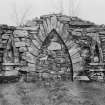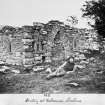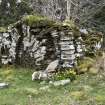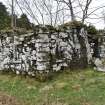Kilneuair, St Columba's Church And Churchyard, Oratory
Burial Aisle (18th Century), Folly (18th Century)
Site Name Kilneuair, St Columba's Church And Churchyard, Oratory
Classification Burial Aisle (18th Century), Folly (18th Century)
Canmore ID 233780
Site Number NM80SE 3.01
NGR NM 88904 03681
Datum OSGB36 - NGR
Permalink http://canmore.org.uk/site/233780
- Council Argyll And Bute
- Parish Kilmichael Glassary
- Former Region Strathclyde
- Former District Argyll And Bute
- Former County Argyll
External Reference (20 July 1971)
Probably 18th century. A 'folly'. Square. Rubble, employing ancient carved
stones (probably from the chapel); roofless. Very curious small windows
formed as acute triangles with slightly curved sides (New built up).
T S Muir "Characteristics of Old Church Architecture" 1861 p 82.
Muir accepts it as an authentic mediaeval oratory.
Information from Historic Scotland, 20 July 1971
Field Visit (April 1985)
BURIAL-ENCLOSURE. Some 4m W of the SW angle of the church there stands a roofless structure measuring 4.3m from E to W by 3.1m over 0.5m walls of lime-mortared rubble. The S side-wall is treated as an ornamental facade, having a central acutely-pointed blind arch flanked by two narrow windows of similar form. Alternate blocks of the arch-surround, and also of the angle-quoins of this facade, project boldly and are carved in what appears to be a 'Celtic' equivalent of vermiculated rustication, incorporating rosettes, herring-bone, chevron- and key-ornament, and other fanciful devices. Similar motifs are carved on the sills and jambs of the windows, and of two other windows in the end walls. Apart from these embellishments, it is comparable with other family burial-enclosures in Mid Argyll (e.g. Nos. 32, 48, 63), but no monuments are identifiable. It can hardly be earlier than the end of the 18th century, but knowledge of its origin was lost before 1844 when it was described as an 'oratory' associated with the ruined church, while a photograph of about 1870 shows that it was becoming dilapidated (en.11).
RCAHMS 1992, visited April 1985


















